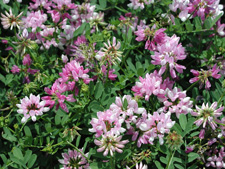Resource Library
Plant of the Week: Vetch, Crown
The University of Arkansas System Division of Agriculture does not promote, support or recommend plants featured in "Plant of the Week." Please consult your local Extension office for plants suitable for your region.
Plant of the Week
Crown Vetch
Latin: Securigera varia

One person’s poison is another’s elixir. This old saying is often true in the plant world. Plants touted as the best thing since sliced bread often have flaws making a mess future generations must deal with. Crown vetch (Securigera varia) is such a plant.
Once touted as the end-all for erosion control along road cuts and other difficult locations, it’s now being considered an invasive weed by many.
Crown vetch - long known as Coronilla varia - has been split off into a new genus as the taxonomic splitters have gained sway in the world of botanical classification. While not a true vetch, this long-lived, fast growing herbaceous perennial legume looks and behaves like one. It grows 1½ feet to 2 feet tall and spreads over a wide area by sprawling across the top of neighboring plants.
It also has underground rhizomes that expand the size of the colony. Reseeding also becomes an important means of spread as the clump becomes established.
It has pinnately compound leaves with 9 to 25 leaflets. Plants begin growing in early spring and the forage produced makes good hay or can be grazed by cattle. Ping-pong ball sized clusters of usually pink, pea-flowers are held above the foliage on short stalks in late spring or early summer. Segmented seed pods are freely produced.
Liberty Hyde Bailey listed crown vetch in his 1914 Cyclopedia, referring to it as a plant sometimes used in the flower border. It was originally native to the Mediterranean region of southern Europe and adjacent areas of North Africa and Central Asia. But it wasn’t until the 1950s when crown vetch really gained a place of prominence, especially in preventing soil erosion.
Penn State University researchers H. Burton Musser and Fred Grau worked on crown vetch breeding for forage and erosion control, eventually releasing a cultivar called ‘Penngift’ in 1953. It was used along the Pennsylvania Turnpike and later promoted relentlessly as the Interstate highway system expanded across the nation in the 1960s and 70s. In 1981, the Pennsylvania legislature proclaimed ‘Penngift’ as the official “Beautification and Conservation” plant of the commonwealth.
Crown vetch appeared to be a winner as an erosion control plant. Its sprawling and creeping ways covered the ground, added nitrogen to the soil and provided pretty pink flowers too. Because it will fix its own nitrogen it will grow in acidic soils too nutrient poor for most other plants.
But, once unleashed, crown vetch was hard to stop. And, as later research showed, it wasn’t all that good at stopping erosion. It turns out that erosion continues more or less unimpeded beneath the tangle of cover that comprises a patch of crown vetch. Today, researchers recommend planting crown vetch with a grass large enough to compete with a mature stand of crown vetch. Crown vetch provides the nitrogen while the fibrous roots of the grass hold the soil in place.
Crown vetch seed is still available and some gardeners like its pretty pink flowers and easy-to-care-for nature. It grows in sunny sites on sandy or clay soils and once established will survive extreme drought. It’s hardy to zone 4 north but is less well adapted in hotter parts of the United States.
It may have a place on larger properties along long, barren roadcuts where it can be contained by mowing around the perimeter. It’s not appropriate for use in smaller spaces where its sprawling ways are likely to crowd out more desirable species.
By: Gerald Klingaman, retired
Extension Horticulturist - Ornamentals
Extension News - July 13, 2007
The University of Arkansas System Division of Agriculture does not maintain lists of retail outlets where these plants can be purchased. Please check your local nursery or other retail outlets to ask about the availability of these plants for your growing area.